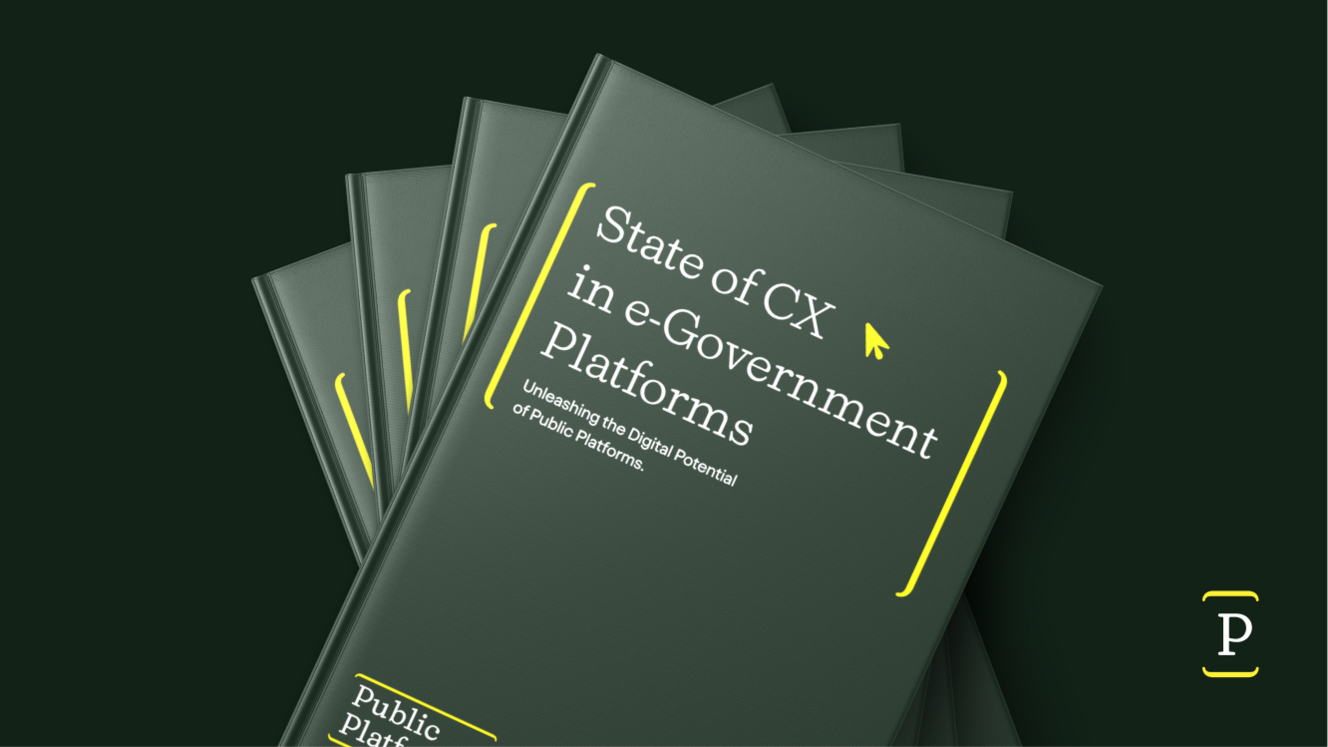
Aleksandra Osińska
-
Feb 22, 2024
-
8 min read
Introduction
In today's world, people are accustomed to seamless digital experiences. This means that citizens are not just passive users of government services but active participants who want to shape their civic interactions. However, many digital public platforms face difficulty meeting these evolving expectations.
While companies like Netflix and Revolut have set a high bar for customer experience, the public sector lags behind, facing additional challenges, such as security measures, compliance regulations, and jurisdictional nuances. Governments cannot simply replicate the best practices of the private sector giants. Instead, they should seek guidance and inspiration from their counterparts' successes in the public sector.
What is the role of digital public platforms?
Digital public platforms are online portals that provide electronic access to government services and information to citizens, businesses, and other stakeholders. These platforms leverage information and communication technologies to improve the efficiency, accessibility, and transparency of government services.
E-government platforms offer a wide range of services and functions that include but are not limited to:
Online Services: Citizens can complete transactions and access government services, such as applying for permits and licenses, paying taxes, renewing documents, and submitting forms online.
Information Portals: These platforms serve as central hubs for accessing information about government programs, policies, regulations, and procedures, including public services, social welfare programs, healthcare resources, educational opportunities, and more.
Communication Channels: Citizens can communicate with government agencies, officials, and representatives through the platform. For instance, online help desks, customer support chatbots, feedback forms, and community forums.
Overall, digital public platforms play a pivotal role in modernising government operations, improving service delivery, optimising costs, increasing citizen engagement, and promoting transparency and accountability in governance.
Why does customer experience matter on a public platform?
Customer Experience (CX) goes beyond user convenience; it embodies the essence of citizens' interactions with digital government services. It encompasses the ease of access, efficiency of processes, and overall satisfaction individuals experience when utilising these platforms. The importance of prioritising CX on public platforms cannot be overstated, as it directly influences citizens' trust, satisfaction, and engagement with government services.
The crucial benefits of well-crafted CX in public platforms
One of the fundamental reasons why CX matters on public platforms is its role in fostering transparency and accountability within government operations. When citizens encounter well-designed platforms that offer intuitive navigation and streamlined processes, they are more likely to trust the information and services provided. This trust forms the foundation of a strong relationship between citizens and governing bodies, ultimately enhancing the overall effectiveness of public service delivery.
Moreover, investing in CX promotes empowerment and inclusion among diverse user groups. By ensuring that digital government services are accessible and user-friendly for everyone, regardless of their technological proficiency or background, public platforms can bridge the gap between various segments of society. This inclusivity is crucial in promoting equitable access to fundamental services and ensuring no group is left behind in the digital age.
The impact of poor customer experience
On the other hand, achieving a seamless customer experience on public platforms can be challenging. While new technologies offer opportunities for governments to operate more efficiently and responsively, the digital transformation process remains complex. Poorly designed, too complicated, and incomprehensible platforms can discourage citizens from utilising e-services and negatively reflect on the government's delivery capabilities.
The consequences of poor customer experiences on public platforms are significant and should not be underestimated. They often result in higher operational costs and overheads as citizens resort to traditional interaction methods, such as in-person visits or phone calls, requiring more staff for customer service. Moreover, negative encounters can damage the reputation of government agencies, leading to decreased citizen engagement and increased scrutiny.
What is the current state of customer experience on e-government platforms?
The level of customer experience in public platforms varies significantly across countries, reflecting the differences in the development and engagement levels of e-government services. Some countries have made significant progress in digital transformation and are known for their exemplary CX in public platforms. In contrast, others face challenges in delivering satisfactory online services to citizens.
Revealing gaps in e-government services
The availability of digital government services has significantly increased globally, primarily driven by the COVID-19 pandemic, which highlighted the importance of technology in areas such as healthcare, education, and social protection. Despite this progress, there are still concerns about the quality of e-government services.
A survey conducted across 29 countries showed that only 56% of respondents considered the overall quality of services satisfactory. Common complaints include inadequate customer service, lack of information, prolonged processing times, and high service costs. These challenges indicate that although e-government services are becoming more prevalent, there is still room for improvement in enhancing the CX for citizens.
Exploring the global diversity of e-government landscapes
Disparities in the development and engagement levels of e-government platforms are evident across different countries, even within the European Union. Some countries, such as Sweden, Denmark, and Finland, have high engagement rates, while others, such as Romania, Bulgaria, and Italy, lag behind.
Countries that have made significant strides in digital transformation have adopted a comprehensive, whole-of-government approach guided by strategic digital policies and centralised coordination. Notable leaders in this regard include the UK, Singapore, Denmark, and New Zealand. Furthermore, innovative approaches to enhancing e-government services have been showcased, such as Canada's focus on experimentation and Estonia's integration of virtual assistants.
However, several countries continue to face challenges in achieving rapid digital transformation, including coordination issues, limited technological capabilities, inadequate user involvement, and the necessity for broad support.
How to design top-notch e-government experiences?
As we already know, crafting an exceptional customer experience on e-government platforms is crucial, and there is still much work to be done in this area. That's why we analysed 14 e-government platforms and compiled insights into the 'State of CX in e-Government Platforms' report. Below, you can find a few of the best practices governments can adopt to improve customer experience and establish trust in their digital services.
Ensuring compliance with Web Content Accessibility Guidelines (WCAG)
Accessibility is a cornerstone of inclusive design. By ensuring compliance with WCAG, governments can guarantee that their digital public platforms are accessible to users of all abilities, including those with disabilities or impairments. Prioritising accessibility not only facilitates streamlined access for everyone but also enhances the effectiveness of service requests, making the platform more user-friendly and inclusive.
Benefits:
- Streamlined access for all users, regardless of abilities.
- Reinforced public trust and a positive image.
Demanding two-factor authentication for e-identification
Security is paramount in the digital realm, especially when it comes to accessing sensitive government services and information. Implementing two-factor authentication as part of the login process adds an extra layer of security, mitigating the risk of identity theft and unauthorised access. By requiring users to provide both a password or PIN and a secondary authentication element, such as a one-time code, governments can significantly enhance platform security and protect users' sensitive data.
Benefits:
- Prevention of fraud and unauthorised access.
- Reinforced platform security.
Designing the platform as an open knowledge hub
Providing citizens with the correct and accessible information is essential. To achieve this, e-government platforms should be designed as comprehensive knowledge hubs that cover various government topics and services. Structuring the platform as a unified resource for all matters related to government affairs will assist users in finding the information they require quickly and easily, resulting in increased engagement and trust in the platform.
Benefits:
- A unified resource for all matters.
- User-centric content taxonomy.
- Highly informed and confident users.
Communicating the user's current position in a process
Clear communication and transparency are key components of a positive user experience. It's crucial to provide users with a clear understanding of their current position within a process, whether it's a service request or an application procedure. By offering clear indicators of the completed steps and those remaining, governments can enhance user confidence, facilitate efficient issue resolution, and improve support.
Benefits:
- Increased user confidence.
- Effective issue resolution and support.
Establishing a unified design system across the platform ecosystem
Consistency is key when it comes to building trust and familiarity with users. A unified design system helps achieve this by ensuring a consistent visual and navigational experience across all digital public platforms and services. By defining standardised guidelines and components, governments can streamline platform maintenance and scalability while reinforcing their commitment to quality and user-centric design.
Benefits:
- Improved consistency across all platforms.
- Efficient platform maintenance and scalability.
- Increased government credibility.
Implementing interactive, automated support channels
Efficient support services are crucial to enhance user satisfaction, but utilising human resources in it can be both challenging and expensive. That's why implementing interactive and automated support channels, such as chatbots, is so important. By doing so, governments aim to provide immediate assistance and personalised responses to user inquiries. This proactive approach not only improves support efficiency but also reduces the workload on administrators, ultimately enhancing the overall user experience.
Benefits:
- Versatile and tailored assistance.
- Immediate resolution of user concerns.
- Cost-efficiency.
Using accessible copy
Clear and understandable language is crucial for building trust and ensuring user familiarity on e-government platforms. By using simple language and avoiding technical jargon, governments can create a transparent and user-friendly experience. Moreover, standardising terminology and simplifying complex concepts can make information accessible to users of all literacy levels, which, in turn, facilitates efficient issue resolution and support.
Benefits:
- Reduced risk of misinterpretation.
- Augmented inclusivity.
- Efficient content management.
Learn from the best
To access a complete and comprehensive list of best practices and recommendations, download our report on global public platforms. By adopting these best practices, you can improve the customer experience on e-government platforms, promote inclusivity and accessibility, and ultimately establish trust and engagement with citizens.
Summary
Understanding the importance of customer experience on public platforms is crucial. Therefore, it is necessary to start working on it. As mentioned earlier, the best solution is learning from peers' success in the public sector. To achieve this, download our comprehensive report that will help you improve CX on e-government platforms and transform your digital government presence.




















